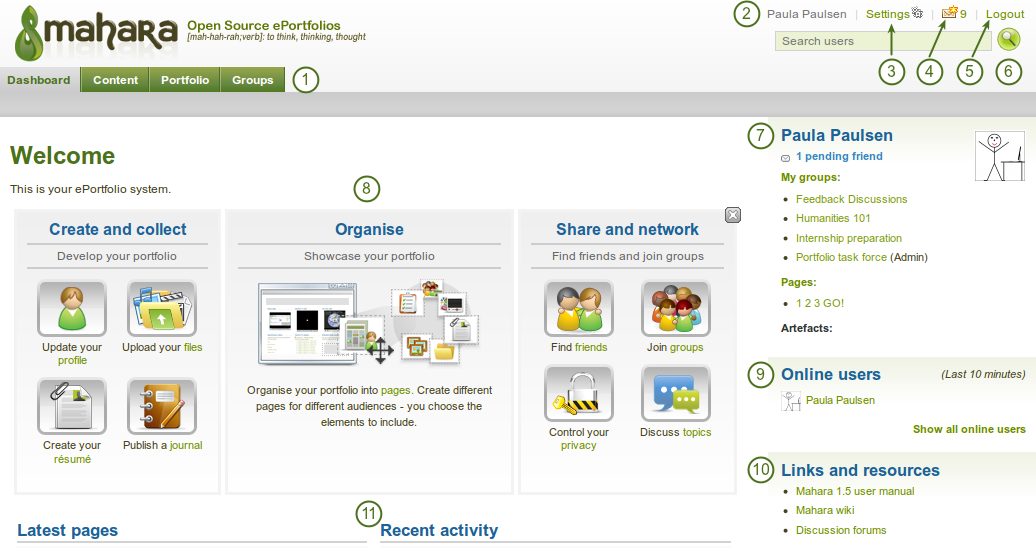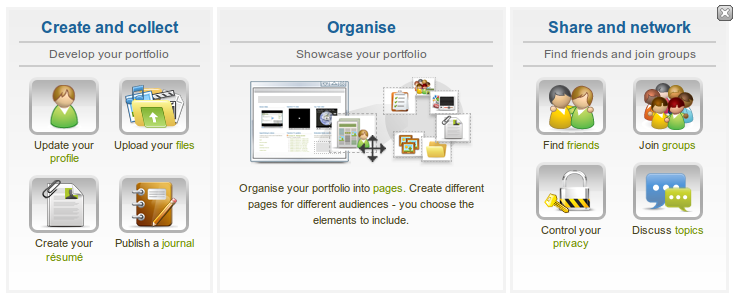2. Dashboard¶
2.1. Login¶
You always need a login to authenticate yourself and access your personal information, portfolio pages and groups that you belong to. You can log in on the Mahara homepage.

Login form
- Username: Type your username in this field (not for Persona, SSO or Moodle accounts).
- Password: Provide your password. If you enter your password incorrectly 5 times in a row during one session, access is locked for 5 minutes before you can try again.
- Click the Login button to access your account.
- Lost username / password: If you do not remember your username or password to your account, click this link to be taken to a page where you can request an email with your details. It will contain your username and a link to change your password.
- Register: If you do not have an account, and your institution allows self-registration for an account, use this link and follow the instructions on the next page.
- Persona login: If you log in via Persona, please use this login button instead of the login form.
- SSO login: If you log in via your institution’s SSO (single sign-on) account, please use this button to be taken to the SSO login.
Note
The regular login form is only available for internal and LDAP accounts. Internal accounts are accounts for which you registered through your Mahara site or that were created by administrators either manually, or by a CSV file upload.
The “Lost username / password” link only works for internal accounts where you use the regular login form.
If you log in via Persona, SSO or Moodle for example, you must retrieve your password directly from these services. If you do not know how to do that, please ask your administrator.
You only see the Persona and SSO buttons if these authentication methods have been enabled on your site.
After you successfully logged in to Mahara, you see your Dashboard. This is your homepage where you can see the latest activity of you and other users on Mahara. You can customise the dashboard so that you always see the items that are most important to you.
Only you can see your dashboard. Nobody else has access to it.
2.2. Overview¶
You can change certain aspects of your dashboard, namely the user-specific information, but a lot of what you see is static to allow you to quickly access other parts of Mahara.

Your homepage is your dashboard from which you can access a number of areas in Mahara conveniently.
- General navigation bar: Move from one area of Mahara to the next. This can be done by having a second-level navigation that is tabbed or a drop-down menu.
- Username: The username is displayed to indicate who is logged in esp. when viewing portfolio pages where the profile block is not visible. This feature is only present when small page headers are not turned on.
 You can click on it to go to your profile page.
You can click on it to go to your profile page. - Settings: This link gives you access to your account settings and notifications.
- Inbox: Go to your Mahara inbox to check for new messages. When you have unread messages, the counter displays the number of unread messages.
- Logout: Link to log out of your current session.
- User search: Search for users who have an account to view their profile page and check which pages they have made accessible to you.
- Personal information: In this box a number of constant and dynamic information is displayed:
- Your name is linked to your profile page.
- Your profile picture is linked to your profile page.
- If you are a member of any groups, they are displayed here.
- Pending friend requests and group invitations are displayed.
- If you tagged artefacts or pages with the tag “portfolio”, a link to them is placed here.
- Quick links: These quick links take you to certain areas of Mahara quickly.
- Online users: If this sidebar block is enabled, you see users who have been logged in during the last 10 minutes. Depending on the settings for your institution that the administrator chose, you may see all users, only users from your institution(s) or no users at all.
- Links and resources: List of links to web sites or documents that are visible to all logged-in users or the public.
- User-specific information: You can customise this area on your dashboard to put blocks there that you want to see every time you log in.
Note
In the User search box you can most often search for users’ display name. Depending on the settings that the site administrator made, you may also be able to search for users’ real name and username. If the site administrator allowed users to hide their real name, you can do so in your general account options.
To provide you with the most relevant search results, you automatically search only for users within your own institution, but can choose to search for everyone on your Mahara installation on the “Find friends” search page you are taken to.
If the site administrator turned on exact user search, you need to provide the correct display name or real name in order to find another user.
 When you display messages from other users on your dashboard through the My inbox block, you can see quickly which messages you have not read. They are marked in bold and have a closed envelope. Messages you have read are indicated by an open envelope.
When you display messages from other users on your dashboard through the My inbox block, you can see quickly which messages you have not read. They are marked in bold and have a closed envelope. Messages you have read are indicated by an open envelope.
Unread messages have a closed envelope and are displayed in bold whereas read messages have an open envelope
2.3. Quick links¶
When you log in to Mahara for the first time, you see three boxes with quick links:
- Create and collect: Develop your portfolio
- Organise: Showcase your portfolio
- Share and network: Connect with friends and collaborate in groups

Mahara information
With the help of these quick links you can reach the different parts of your portfolio directly from your dashboard.
Note
If you removed these boxes from your dashboard but want to get them back at a later point, you can re-active them under Settings → Homepage information.
2.4. User-specific information¶
The default dashboard includes the following blocks:
- Latest pages
- My pages
- Recent activity
- Topics I’m following
These areas are filled with content once you start using Mahara and create pages, receive messages from other users, have access to others’ portfolio pages and use the forums for discussions. You can customize this area to your liking by editing your dashboard in Portfolio → click the Edit button  next to the dashboard page → change the blocks like you would change them on any page in Mahara.
next to the dashboard page → change the blocks like you would change them on any page in Mahara.
See also
Refer to the page editor for more information on adding and removing blocks from a page.